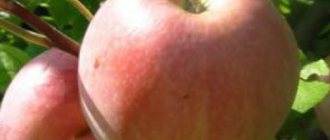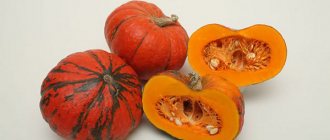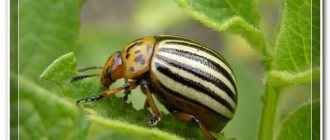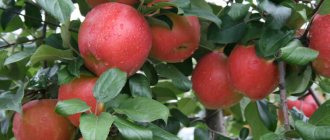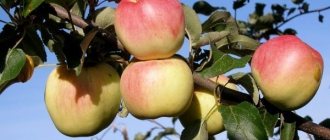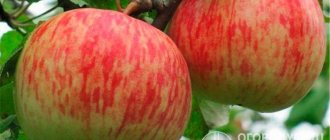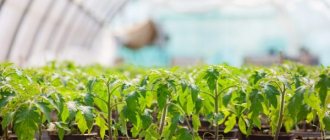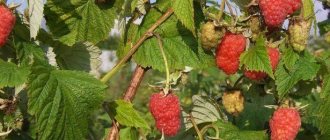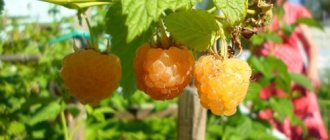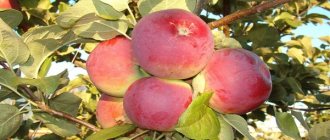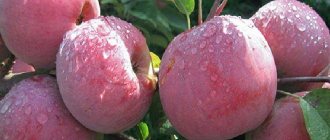The Michurinsky Garden of the Timiryazev SA conducted varietal tests of a huge number of varieties and hybrids of apple trees obtained by various breeders and scientific research institutes of Russia. Over the course of several years, their performance in terms of winter hardiness, taste, apple weight, yield, and disease resistance were assessed. Second place after such large-scale research tests was taken by the Moscow apple variety later.
Let's take a closer look at the test winner.
Description, photo
The hybrid was bred in the early 60s by breeders of the Moscow Society of Natural Scientists at Moscow State University named after M.V. Lomonosov by crossing the new Cinnamon and the Northern Sinap variety. The author was the famous breeder S.I. Isaev.
Official zoning took place much later – 40 years later.
Refers to late winter ripening varietal crops . The tree is tall. While the tree is young, the crown is characterized by a wide pyramidal appearance, which over the years turns into a rather wide oval.
The color of the trunk and main branches is green-gray. The main arrangement of branches is vertically inclined. The sheet covering is characterized by average performance.
The shoots are smooth, round in shape, have strong pubescence and a brownish-brown tint. The sections of the stem between two adjacent shoot nodes are short. The leaves are large, have jagged edges and short, fleecy petioles.
The fruits are considered quite large. The usual weight is about 160 g, but specimens grow up to 230 g. The apples are smooth, round, and cone-shaped.
The skin is smooth, without pearls and ribs. Important! Removable maturity coincides with consumer maturity.
The main color of apples: yellow-green. A slight blush appears on . After long-term storage, the color changes to golden and resembles a waxy fruit.
Fruits of the Moscow apple tree later.
additional characteristics
Advantages and disadvantages
Pros:
- Incredible shelf life;
- Excellent consumer characteristics;
- Tolerates winter well;
- It is resistant to scab.
No significant deficiencies were identified. A small disadvantage is the thickening of the crown without proper formation.
Dimensions of an adult tree
The tree is tall. Without proper pruning and shaping, it can reach a height of 5-6 m and cause inconvenience in care. In addition, it shades other crops.
Annual growth
The growth of apple trees every year is not very large. On average it is about 10 – 15 cm.
Frequency of fruiting
If the rules of care and formation are followed, the apple tree bears fruit annually . The difference may be a small amount of yield. If you do not thin out the ovaries or flower stalks, fruiting usually occurs within a year.
You can learn more about the frequency of apple tree fruiting from this video:
Productivity
At the amateur level, the yield of one plant is 150 kg. For industrial cultivation, 100 c/ha.
The Moscow apple tree harvest is later.
Vitamin content and tasting rating
The apple pulp is juicy and has a sweet and sour taste . The aftertaste is characterized by a slight spice. The pulp is dense, with a fine-grained structure, and whitish in color. The tasting score is 4.3.
Moscow apple later.
According to the chemical composition in fruits:
- The percentage of sugars depends on the area and climate of cultivation. Ranges from 8.5% to 11.3%;
- The concentration of acids in the neutralization reaction (titrated) is 0.94%;
- Phenolic compounds with tanning properties – 55 mg per 100 g of product;
- Ascorbic acid – 8.8 mg per 100 g;
- P-active substances – 0.15 mg per 100 g;
- Pectin – 8.7% by dry weight.
Apples are very useful.
Winter hardiness and disease resistance
Resistance to low temperatures exceeds average values, therefore it is considered ideal for Central Russia.
It has relatively good resistance to the main disease of the crop - scab.
Apple scab.
Reviews
Anna. “I grow several types of winter-ripening apple trees at my dacha. And this species is among them. I prune so that there are 4 tiers of branches. I'll keep an eye on this in the spring and fall. This makes it possible for the tree to bear fruit every year.”
Irina. “We love this taste in early spring, when there is only import in the stores. The apple tree is already more than 15 years old and there has been a failure in yield only five times. And so we annually remove up to 10-12 buckets from an already quite tall tree.”
Paul. “Moscow later is the type of apple that every gardener needs to plant. Many people complain about tall growth and thickening. But you need to at least sometimes work with the crop and take care of it, and for this you need to study the photo and description of the variety. I form the crown from the very beginning of planting and do not allow the plant to thicken and grow into a multi-story building.”
Diseases and pests
A serious disease is apple tree cancer. It can lead to the death of the tree. Noticeable thickenings appear on the trunk, branches and crown. Later, the process of rotting develops in these growths. Damage is not only open, but also closed. In the latter case, the bark peels off. If left untreated, a red border appears at the site of the damage.
If the disease is detected at an early stage, the damaged areas are lubricated with either garden varnish or Bordeaux mixture. Damaged branches must be burned outside the garden.
Features of planting and care
A feature of planting tall apple trees is the “correct step” between plants . Compliance with this rule will enable trouble-free tree care.
Important! When purchasing a seedling, pay attention to its trunk. Curvature may mean a damaged root system or the invisibility of the root collar. It is better not to purchase this one in order to avoid death or further deformation of the trunk.
The purchased seedling needs to be shortened. Artificial shortening in growth depends on the size of the rootstock. On average, approximately 80 – 90 cm is left.
Watch a video on how to choose an apple tree seedling:
Planting dates and scheme
Moskovskoe later has the same planting dates as other seedlings of this fruit crop - spring and autumn:
- Autumn can be carried out even after snow has fallen. The main thing is that the ground is not frozen yet. If you plant a tree earlier than two weeks before the cold weather, it may wake up and begin to grow. And to go into winter it must remain dormant;
- Spring planting is carried out some time after the soil thaws and before the buds open.
Tall species are planted according to a 5x5 m pattern.
Agricultural technology and cultivation
An important agrotechnical measure is the correct selection of soil , which affects the survival rate and the amount of fruiting.
This can happen when planting on acidic or dense clay soil. But even on such soils it will grow and bear fruit if the acidity is quenched with saltpeter, and if the soil is heavy, a good-sized planting hole is made and enriched with fertile soil, fertilizers and river sand.
The ideal soil for an apple tree is loam with a groundwater depth of at least 3 m.
Loam is the best soil for an apple tree.
The hole is prepared in advance; the depth should be at least twice . It is better to prepare a hole 1 x 1 x 0.7 m a month before planting.
The excavated soil is thoroughly mixed. A third of the resulting mixture is fertilized:
- 3 buckets of well-rotted manure;
- A glass of ash;
- about.5 kg of superphosphate;
- 4 tbsp. spoons of potassium sulfate.
It is loosened to the planting hole. The fertilized third of the soil is poured out, and then the rest of the soil without nutritional additives.
Planting pit diagram.
For the first couple of years, it is advisable to tie the apple tree to a peg . When planting, it is necessary to control the placement of the root collar above the ground surface. This level should not be less than 5 cm.
Recommendations! To obtain a decent harvest and high consumer quality of fruit, the plant needs annual pruning and shaping, as well as systematic nutrition. Treatment with chemicals is used only for prevention. This variety is very rarely affected by scab.
In order for the tree to take root better, the first flowering should be completely removed . In subsequent years, the yield should also be normalized by thinning the fruits at the greenfinch stage. The remaining apples will be much larger, tastier, and this will give strength to prepare the plant for the winter.
To obtain large apples, the harvest should be rationed.
also needs regular (5 times a month) watering. A bucket of water in the morning and evening. This is especially important during the fruiting period. Because it is during this period that next year’s harvest is formed. And due to lack of moisture, both the current and the next harvest may be missed. For young plants, one-time, but abundant watering per month is enough.
Watering stops at the end of August to prevent prolonged growth of shoots and not to disrupt the winter hardiness of the crop. But at the same time, it is necessary to prevent the soil from drying out and overflowing.
Moscow later needs regular watering.
Although the variety is considered winter-hardy, young trees need protection . To do this, the tree trunk circle needs to be mulched with compost or humus (preferably horse humus) with a layer of at least 10 cm. And the trunk should be whitened and wrapped with a special rodent net.
Watch the video on how to prepare apple trees for winter: The tree trunk circle should always be kept clean and subject to loosening.
Scheme of the tree trunk circle.
Pruning and crown formation
Two years after planting, the apple tree begins to form:
- The emerging branches are removed from the trunk;
- Branches that grow steeply vertically up or down are pruned;
- Shoots more than half a meter long are pruned;
- Last year's growth is thinning out.
The activity of branching and the formation of fruit buds is stimulated by cutting off part of last year's shoots and older branches.
Proper pruning allows you to control the yield, the amount of sugars in the fruits and leaves the plant with the strength to fight various diseases.
The main stages of forming and pruning the crop:
- The planted young seedling is pruned by 1/3 to stimulate crown formation;
- The process of shaping and pruning is carried out annually in early spring before the buds open;
- Autumn pruning is a sanitary measure. It is carried out after the leaves have fallen. Damaged, diseased and dry branches are removed;
- If the entire branch is removed, no stump is left. The cut occurs at the very base;
- It is better to remove branches that fall to the ground under the weight of the fruit;
- weak and crooked young shoots must be cut off. Only strong and even ones are left;
- Trimming a large number of branches and shoots is not allowed. The proportion of removal should not exceed a quarter of the total amount. Otherwise, the tree receives severe stress, from which it becomes ill.
Apple tree pruning diagram.
For more information on pruning apple trees, watch the video below:
Harvest and storage
The ripe fruits of Grushovka Moskovskaya are not able to hang on the tree for a long time, so it is better to collect slightly unripe fruits. In a cool room they will retain their characteristics for 2-3 weeks. If apples are picked at full ripeness, they are immediately eaten or processed.
Preparing for the winter season
Mature trees do not need insulating shelter ahead of the winter season. To avoid freezing of the roots of young apple trees in the first year of planting, the trunk circle is covered with dry humus.
To protect against rodents looking for food in winter, the trunks of young trees are wrapped in rags or a mesh fence is installed.
The Grushovka Moskovskaya apple tree is not suitable for growing commercially, but is an excellent summer variety for summer residents and gardeners. By following simple rules of care, the apple tree will delight you for many years with early and rich harvests of delicious fruits.
Features of ripening and fruiting
Fruiting
Start
Interestingly, during selection, fruiting was planned for 10 years after planting. This was the result of the original tree. But its seedlings began to bear fruit much earlier. Therefore, after planting a seedling, usually the first normal harvest appears in the 7th year.
Moscow later begins to bear fruit in the 7th year.
Peculiarities
As such, there are no characteristics of fruiting in the variety, except for the fact that consumer maturity coincides with removable . According to gardeners, the apple tree is unpretentious, has stable, decent yields and high taste qualities of apples.
Deadlines
Blooms
Flowering begins in the second decade of May and lasts a little more than a week . Also, weather conditions can make adjustments to the timing of flowering.
Fruit ripening
Ripening later. The harvest begins around the twentieth of September.
The fruits of Moscow late ripen at the end of September.
Harvest storage
This apple tree is distinguished by the length of its storage. Apples can retain consumer characteristics until June . And under the right conditions they can be stored until a new harvest.
Region of growth
The Moscow apple tree variety, due to its sufficient winter hardiness and high immunity to major diseases, is later cultivated in the Moscow region, Leningrad region, most of Russia, as well as in the northern and mountainous regions of Scandinavia.
The Moscow apple tree variety later has mostly positive reviews in gardening circles. It is especially valued for its high productivity with minimal maintenance. The main thing is to choose healthy seedlings, without any damage or signs of disease on the roots, and to adhere to the correct agricultural practices. Only an integrated approach will allow you to reap a healthy and abundant harvest.
The Michurinsky Garden of the Timiryazev SA conducted varietal tests of a huge number of varieties and hybrids of apple trees obtained by various breeders and scientific research institutes of Russia.
Over the course of several years, their performance in terms of winter hardiness, taste, apple weight, yield, and disease resistance were assessed. Second place after such large-scale research tests was taken by the Moscow apple variety later.
Moscow apple tree later
Winter
Moscow winter is the most winter-hardy variety . The fruits are harvested at the end of September and even the beginning of October. They are quite large and reach 250 g. The color of apples is dark red with subcutaneous yellow dots. Fragrant, sweet and sour taste. Stored until June.
Moscow winter.
Columnar
Moscow necklace - height up to 2 m. Apples from 150 to 250 g, red color and dessert taste. Winter-hardy and scab-resistant species.
Moscow necklace.
Subtle nuance! The columnar Moscow Amber apple tree is not a variety, but a confusion in the names. There are only the Moscow Necklace and the Amber Necklace.
On a dwarf rootstock
The tree grows up to 3 m high and has all the properties of the Moscow late tree.
Kinds
There are several subspecies of the Moscow late variety, which differ only slightly in properties, but radically in the size of the tree.
Winter
The Moscow apple tree itself is winter-hardy. It has large, tasty fruits, aromatic and very attractive. There is no other, even more resistant variety.
Columnar
Moscow can later be grown in the form of a column. The apple tree retains its resistance to scab and low temperatures, but at the same time it becomes significantly shorter in stature and acquires a very compact crown. The taste and size of the fruit are also preserved.
On a dwarf rootstock
The variety can be cultivated on a dwarf rootstock. In such cases, the growth of the apple tree stops at three meters, and all other properties are preserved.
